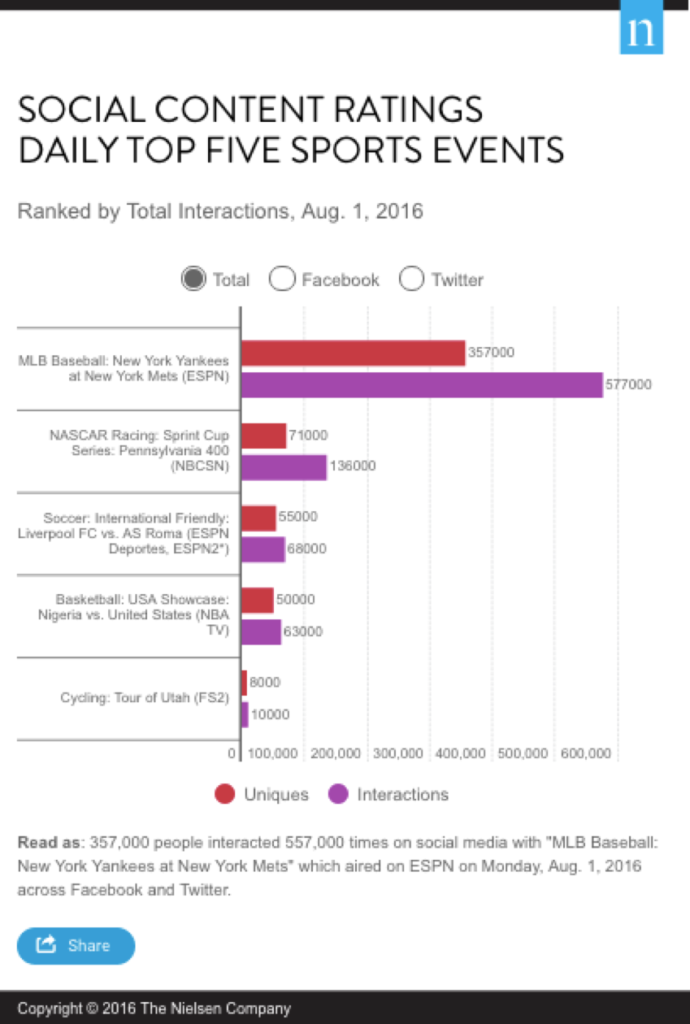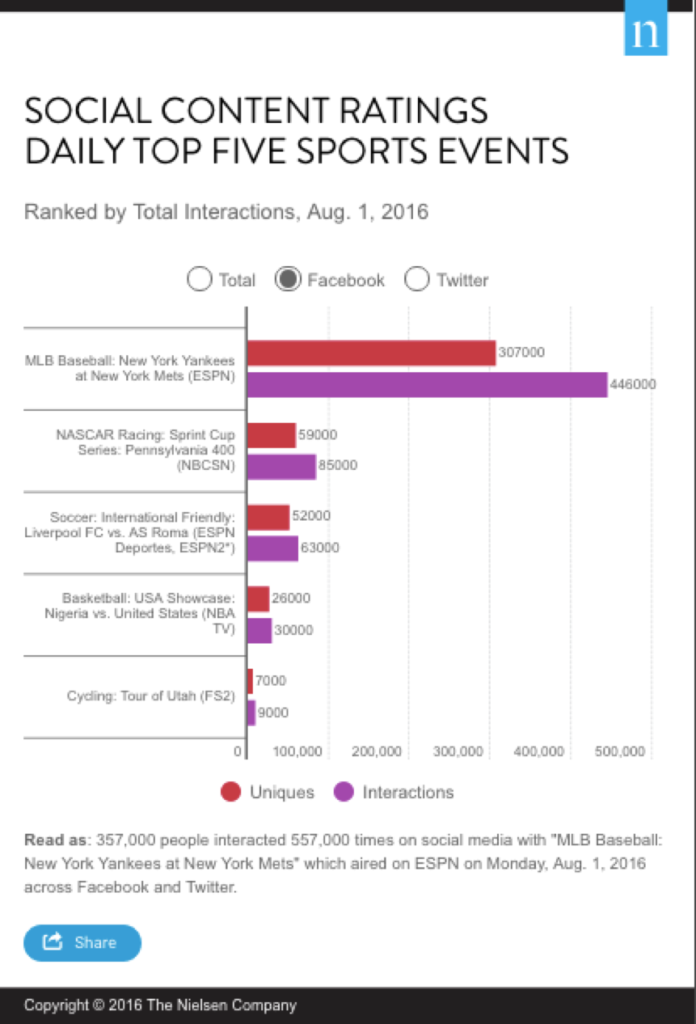Finally: Nielsen Social Content Ratings Add Facebook
A few weeks ago, the BRaVe team was given a tour of the new Nielsen SCR by Sean Casey. After years of helping to define and drive the metrics that make up the 'official" measurement system around Social TV, we can finally say this: Nielsen Twitter TV ratings are officially a thing of the past. FB joins the fun and Nielsen is finally bringing a more balanced and accurate view of what's really happening in our living rooms.This is because Nielsen just announced Nielsen Social Content Ratings - their comprehensive measurement of TV based conversations and engagement on BOTH Twitter and Facebook. This new rating will help TV networks, agencies, and advertisers maximize the social impact of their cross-platform strategies. Utilizing over a million classifiers, Nielsen will be measuring organic and owned activity around television on both platforms on a 24/7 basis. This measurement applies to both linear and OTT broadcasts.With Social Content Ratings, advertisers will be able to measure the performance of social activity related to television programming across Twitter and Facebook using standardized measures and third-party data. For example: Monday night’s Mets / Yankees game, where a bad bullpen decision lead to the Mets giving up the lead in the eighth and failing to convert with two on and two out in the tenth to lose the game, saw 577,000 total reactions and 357,000 total unique authors. Of these, Facebook made up 86% (446K) of the reactions and 77% (307K) of the unique authors – and this was from a game that mainly interested those in the New York DMA.Here’s the kicker: It is worth noting that while this game was broadcast on ESPN, YES, and SNY, the average Mets game receives 280k viewers this season and the average Yankees game 234k. This gives credence to something that many of us have known for quite some time, but for the first time, Nielsen is finally indicating that social may not be just a small compliment to live viewing – it may actually be larger, much larger The Social Content Ratings will track and measure television-related social activity—both authored content-like posts, and engagement activity like comments and retweets—across Twitter and Facebook. To do this, Nielsen systematically identifies and tracks accounts, hashtags, names and other keywords associated with television programming. This data is combined with engagement data from the more than 44,000 owned social accounts Nielsen tracks on behalf of networks, shows and talent, creating a holistic and standardized view of social engagement happening not only when programs air, but at any time. Twitter will remain real-time and Facebook will be shown in 5-minute periods, with authorship and engagement visible within each 5 minute block.The measurement framework for Social Content Ratings adheres to the Media Rating Council's Social Media Measurement Guidelines, noted Sean Casey, President of Nielsen Social. In November 2015, the MRC issued the first version of these guidelines with other industry group sponsoring and providing input, including 4A's, IAB and WOMMA. The guidelines seek to establish a set of methods, definitions and common practices for the measurement of social media activity. Nielsen, along with using these guidelines as their framework, was also a participant in their creation.When asked to define how things are being measured, Nielsen responded that they will be publishing their methodology to provide transparency to the market with the launch of Social Content Ratings.
The Social Content Ratings will track and measure television-related social activity—both authored content-like posts, and engagement activity like comments and retweets—across Twitter and Facebook. To do this, Nielsen systematically identifies and tracks accounts, hashtags, names and other keywords associated with television programming. This data is combined with engagement data from the more than 44,000 owned social accounts Nielsen tracks on behalf of networks, shows and talent, creating a holistic and standardized view of social engagement happening not only when programs air, but at any time. Twitter will remain real-time and Facebook will be shown in 5-minute periods, with authorship and engagement visible within each 5 minute block.The measurement framework for Social Content Ratings adheres to the Media Rating Council's Social Media Measurement Guidelines, noted Sean Casey, President of Nielsen Social. In November 2015, the MRC issued the first version of these guidelines with other industry group sponsoring and providing input, including 4A's, IAB and WOMMA. The guidelines seek to establish a set of methods, definitions and common practices for the measurement of social media activity. Nielsen, along with using these guidelines as their framework, was also a participant in their creation.When asked to define how things are being measured, Nielsen responded that they will be publishing their methodology to provide transparency to the market with the launch of Social Content Ratings. One interesting thing to note about these new ratings is that they blend Twitter and Facebook. For the longest time, Twitter’s rules of the road demanded that they be broken out separately from other sources. Casey noted that the Social Content Rating is “the sum of Total Uniques and Total Interactions across Twitter and Facebook for a given TV episode.” This indicates a change in the rules, something only a company as large as Nielsen could have pushed. Whether this change will apply to other companies doing ratings with multiple sources remains to be seen, but it is a good first step.TV isn't Twitter's world anymore, in fact, it never really was. We applaud the efforts here to recognize ALL Social platforms and data as viable insights to true audience response and reaction to their favorite shows. Adding Facebook is an amazing next step here for a company like Nielsen. Next up...bring on Snapchat, Instagram, YouTube, Tumblr, Pinterest and whatever else is the next big audience touch point.
One interesting thing to note about these new ratings is that they blend Twitter and Facebook. For the longest time, Twitter’s rules of the road demanded that they be broken out separately from other sources. Casey noted that the Social Content Rating is “the sum of Total Uniques and Total Interactions across Twitter and Facebook for a given TV episode.” This indicates a change in the rules, something only a company as large as Nielsen could have pushed. Whether this change will apply to other companies doing ratings with multiple sources remains to be seen, but it is a good first step.TV isn't Twitter's world anymore, in fact, it never really was. We applaud the efforts here to recognize ALL Social platforms and data as viable insights to true audience response and reaction to their favorite shows. Adding Facebook is an amazing next step here for a company like Nielsen. Next up...bring on Snapchat, Instagram, YouTube, Tumblr, Pinterest and whatever else is the next big audience touch point.
TV[R]EV is written, curated and incubated by the BRaVe Ventures team. Find TV[R]EV on Facebook and Twitter, and sign up for the newsletter to stay up to date on the TV[R]EVOLUTION.

